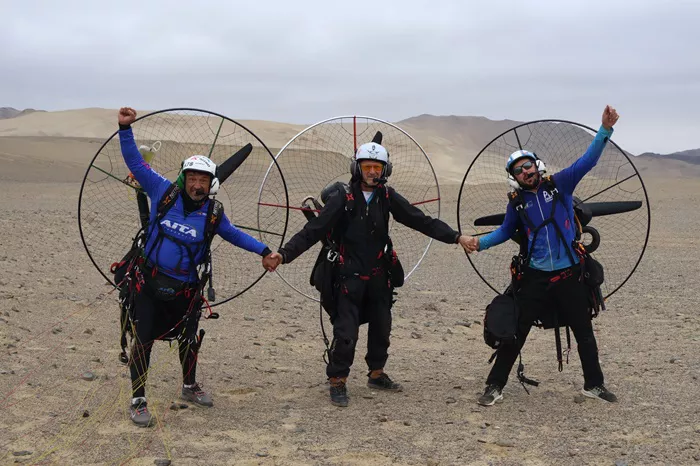In a groundbreaking study published today in Plants, People, Planet, scientists from the Royal Botanic Gardens, Kew, Huarango Nature, and paramotorists from Forest Air, reveal the transformative potential of paramotoring for research and conservation in some of the world’s most delicate and remote regions.
The research highlights how paramotoring offers a faster, more eco-friendly alternative to traditional off-road vehicles, including motorbikes. This method can reach remote areas more efficiently, reduce CO2 emissions by up to two-thirds, and cause minimal damage to fragile desert fog habitats and unexplored biological crusts.
The study details an expedition to Peru’s coastal fog deserts, where Kew scientists, supported by a National Geographic Explorers grant, collaborated with professional paramotorists to explore and document plants in previously inaccessible areas.
With the dual challenges of climate change and biodiversity loss, scientists are urgently seeking new methods to describe and protect endangered plants and habitats. Effective fieldwork is crucial for collecting plant specimens, studying populations, and mapping ecosystems.
The 2022 expedition to Peru’s fog oasis desert, led by RBG Kew and Huarango Nature, faced significant logistical hurdles. Fog oases, unique ecosystems stretching 3,000 km along the Pacific coast of Peru and Chile, rely on seasonal fog due to the area’s minimal rainfall. Despite their ecological importance, these ecosystems are challenging to study due to their remoteness and the harsh conditions.
Dr. Carolina Tovar, Research Leader at RBG Kew, emphasizes the significance of these ecosystems, saying, “The lomas are unique and beautiful, sustained by fog from the Pacific. They transform spectacularly during the lomas season, yet much remains unknown about their ecology, which is essential for effective conservation efforts.”
Innovative Fieldwork Approach
Traditional off-road vehicles can damage delicate desert surfaces, increase erosion, and create lasting tire marks. To address these issues, Kew scientists partnered with Forest Air and the Brazilian paramotor team Aita (Escola Nacional De Paramotor). The paramotorists, trained by Kew and Huarango Nature scientists, learned to identify and collect plant specimens while minimizing environmental impact.
Márcio Aita Júnior, Director of AITA Escola Nacional de Paramotor, reflects on the experience: “This unique opportunity helped me appreciate botany and the significance of preserving our natural world. It profoundly changed my perspective on the importance of conservation.”
During the seven-day expedition in November 2022, the team covered approximately 300 miles by land and air, surveying over 15,000 hectares. The focus was on the “Tillandsiales” habitat, dominated by Tillandsia species, which are difficult to track due to their unique light-diffusing surfaces.
Mike Campbell-Jones, President of Forest Air, describes the mission as a success: “Bringing together scientists and pilots demonstrated the effectiveness of this new tool for scientific research. It was one of the most memorable experiences of my career.”
Efficient and Eco-Friendly Plant Collection
The scientists compared paramotoring to ground-based methods for plant surveys. Paramotorists completed missions up to 10 times faster than ground teams, covering large areas and targeting specific regions not easily reached by drones.
The study also compared greenhouse gas emissions from paramotorists and ground teams. For shorter missions, emissions were similar, but for longer missions, paramotorists produced significantly less CO2. They also caused minimal damage to the desert surface, while off-road vehicles can harm large areas and disrupt ecosystems.
Dr. Justin Moat, Senior Research Leader at RBG Kew, highlights the efficiency of the paramotorists: “Paramotorists covered great distances and returned with valuable plant specimens and aerial photos in just two hours, overcoming challenges that would have required a longer, more damaging expedition.”
The study’s authors hope their findings will encourage the use of paramotoring for fieldwork in remote or sensitive areas. They also aim to inspire a new generation of botanists by demonstrating how extreme sports enthusiasts can contribute to scientific research and conservation.
Oliver Whaley, Honorary Research Associate at RBG Kew, underscores the importance of botanical science: “Plants are crucial to our lives, yet they are often overlooked in conservation efforts. By involving adventurers in scientific work, we can gather essential environmental data and protect our planet.”
A Conservation Victory
The study’s efforts have already led to significant conservation achievements. Earlier this year, RBG Kew and Huarango Nature, with support from The Darwin Initiative, Sainsbury’s, and other partners, successfully established a reserve for the lomas, known as the Lomas y Tillandsiales de Amara y Ullujaya.
This 15,689-acre reserve, located on the Peruvian coast, is home to many rare species and has been protected by the Peruvian Government. It represents a crucial step in preserving these unique ecosystems, though only 4% of lomas in Peru and Chile are currently under protection.
Related topics:
- How to Control Invasive Plants and Protect Local Ecosystems
- Gardener Needs Help After ‘Nightmare’ Plants Overrun Backyard: ‘Handle That Problem Quickly and Thoroughly’
- 8 Indoor Plants That Thrive When Pot-Bound and Don’t Need Frequent Repotting


